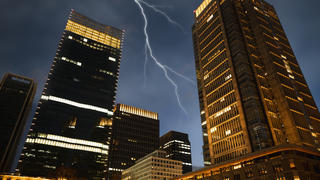Energy’s Main Properties
5 min read
The energy contained in matter is invisible, but light, movement, wind, and waves are some of the ways it manifests itself. Whether in its natural form or harnessed by humans, energy can be transmitted from one object to another, often through conversion. However, it cannot be created or destroyed: the universe contains a constant, finite amount of energy.

© THINKSTOCK - Electric currents are found in nature. The best-known examples include lightning and electric fish.
Primary Energy Versus Secondary Energy
is a form of energy found in nature. Examples include energy from muscles (humans and animals), water (river currents, tides and waves), wind and (oil, , ). But static produced by friction between some materials and the energy from lightning are not considered to be primary energy, because they cannot be harnessed.
Primary energy used on an industrial scale can be broken down into renewable energies (sunlight, water, wind, biomass, etc.) and non-renewable energies such as fossil fuels (oil, coal and gas). (produced by the fission of and plutonium nuclei) is also a form of primary energy.
For the most part, , also called energy carriers, is usually converted by humans from primary energy sources. For example, electricity generated from gas, coal, water, wind or sunlight is a secondary energy. Fuel is another example.
Secondary energy is then converted into final energy available to the user, such as light (in light bulbs), (radiators) and (fans, engines, pumps, etc.).
Different Amounts of Energy in Different Objects
All matter and objects contain a certain amount of energy, which varies according to their properties (position, mass, shape, speed, etc.) For example, a compressed spring contains far more energy than a spring that is not compressed. A raised object has more than an object on the ground. And the faster an object is moving, the more it has.
Energy Transmission and Conversion
Energy can be transmitted from one object or system (a set of connected things or parts) to another. The heat from a radiator is transferred to the air of the room it is in. On a bicycle, the movement of the pedals is transmitted to the wheels. When one marble hits another, it transmits a certain amount of motion.
However, energy often changes form when transmitted. For example, the energy contained in wood is converted into heat and light when it is burned. captured by a wind turbine is converted into mechanical energy, which itself is converted into electricity by a generator. Energy from the Sun is converted into growth factors by plants thanks to a process called .
The law of conservation of mass (or matter) discovered by 18th-century chemist Antoine de Lavoisier states that “nothing is lost, nothing is created, everything is transformed." This applies to energy too. Energy cannot be created or destroyed, only be transmitted or converted. The total amount of energy remains constant, even when it seems to have disappeared.
For example, if you roll a marble on the ground, it slows down and stops, having gradually run out of kinetic energy due to friction. But this does not mean that there is no energy left: the energy has been converted into heat and transmitted to the ground and the air. In fact, the total amount of energy contained in the universe is finite and constant.
When we speak about generating energy, we are not really creating it, but converting it.










